Homemade dog food is such an easy way to spoil your dog and feel great about doing it. All you need is a stove and a large pot to make a yummy and healthy meal for your dog.
This recipe is the stovetop directions to make my Instant Pot Dog Food Recipe. I know not everyone has an Instant Pot (though I totally recommend using one to make life easier 😉 ) so I decided to make directions that everyone can use.
These recipes came about because the commercial dog food options that were available to us didn’t provide exactly what we were looking for in terms of optimal nutrition and we wanted something that didn’t come with unnecessary additives, so we talked to our vet and decided that homemade dog food would be a great option for us.
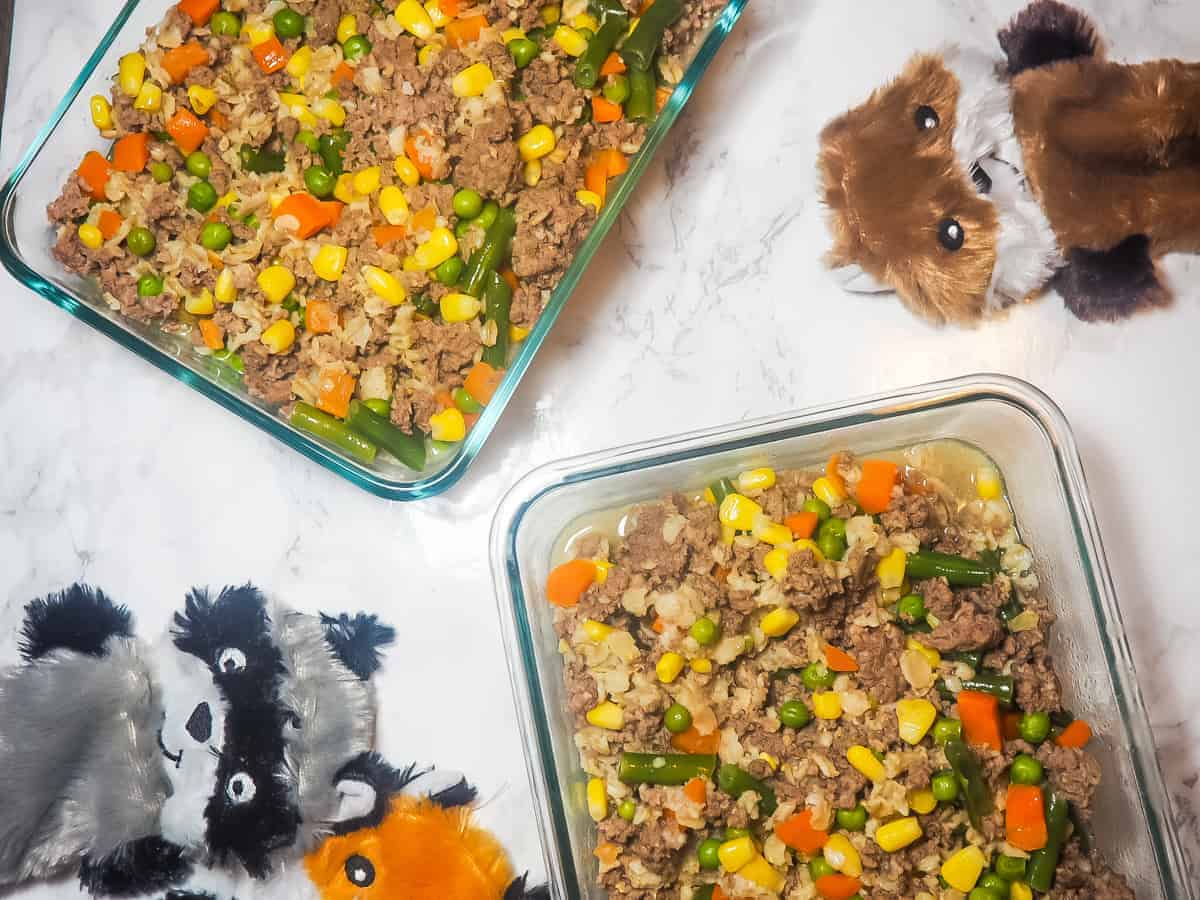
Table of Contents
🥘 Ingredients Needed
This recipe is pretty comparable to what you would get from the grocery store from Fresh Pet (I think Costco sells it in big tubes), except you can control what goes in it, and it’s fun to make it yourself!
The nice thing about making your own DIY dog food is that you can think about your dog’s needs and any food allergies that they might have. Instead of having to read a million labels, you are in control of what goes in the food. If your dog is a picky eater, you can also feed them what you know that they like:
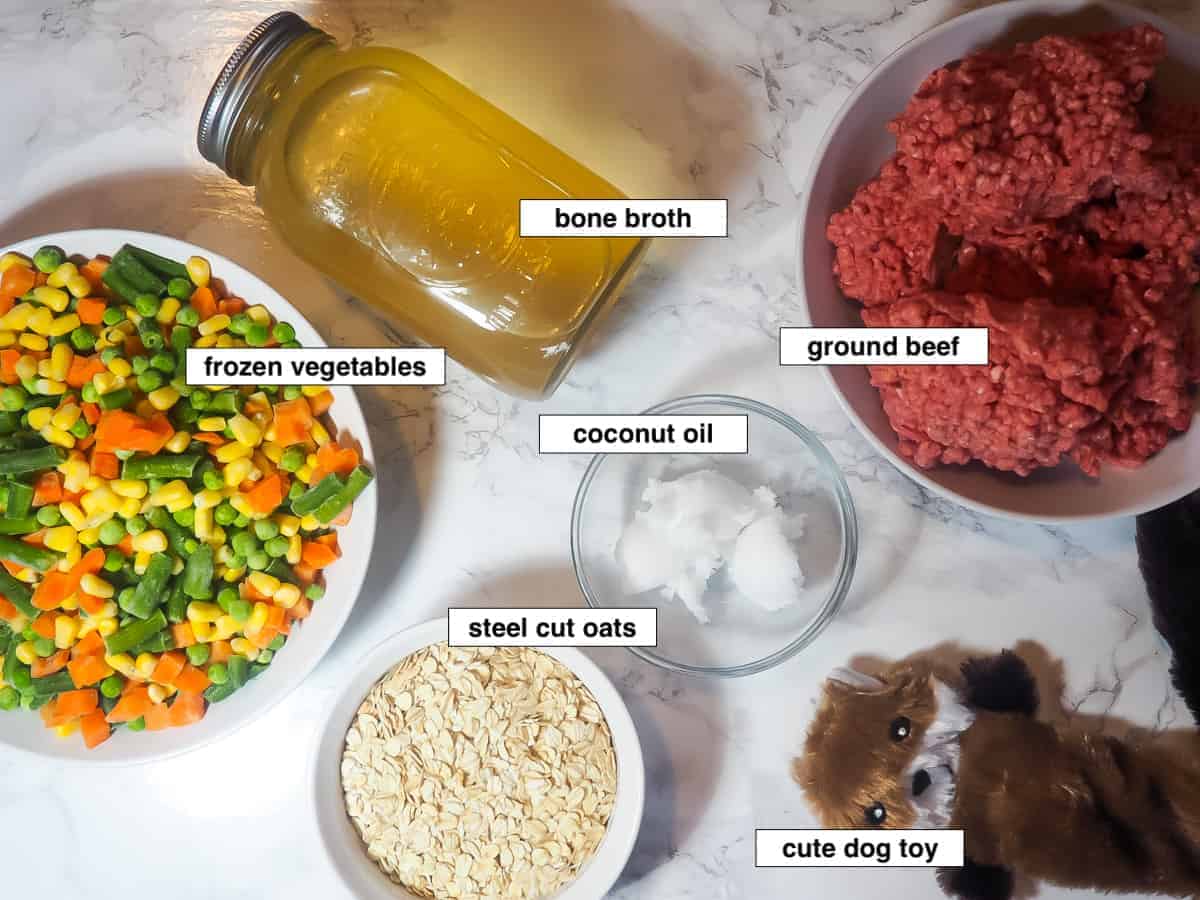
- Meat – I alternate between ground beef, chicken (chicken breast, chicken thighs, or ground chicken – choose organic for ground chicken), turkey or ground turkey, venison, or even fish. We love to share our fish when we have fresh fish that we’ve recently caught. (You can also cook a whole chicken and shred it up if you are feeling really adventurous, but that’s a lot more work. If you cook a whole chicken, be sure that all bones are removed.)
- Healthy Carbohydrates – There’s a lot of conflicting information about whether or not dogs should eat a grain-free diet. When we fed Melly a completely grain-free diet, it actually made her sick. We found that meeting her complex carbohydrate needs in the form of whole grain – rice, oats, rinsed quinoa, or barley – works really well for her. Do what works best for your dog! (See my notes below about bio-individuality.) We also add sweet potatoes, butternut squash, real corn (off the cob), or purple potatoes to her food. (I changed out the picture of this recipe because I was getting sick of explaining to people that corn IS safe for dogs to eat. It provides the same vitamins and minerals to dogs as it does to people – the confusion comes from people recommending against foods where corn is the main ingredient in the food. Corn should be used to supplement a diet, not be the main ingredient in the food, which is the problem with many commercial dog foods. If a human ate only corn, they would have nutritional deficiencies as well!)
- Frozen or Fresh Vegetables that are chopped into bite-size pieces – Our dog loves green beans, carrots, peas, broccoli, spinach, squash, corn, and potatoes.
- Chicken or Beef Bone Broth – I use homemade bone broth, but you can use any kind of none broth or stock that does not have onions in it.
- Coconut Oil – Our dog LOVES the taste of coconut, so we use unrefined coconut oil. You can use whatever you have! You can also leave this out and squirt fish oil into the food when serving instead.
Optional (Add after cooking/when serving)
- Fruit – So many fruits are great for dogs – we love feeding blueberries, strawberries, apples, bananas, avocados, and tomatoes. (With apples, avoid the seeds, and with avocado, avoid the skin and pit.)
- Kefir
- Supplements – We give our dog food-grade bone meal, organic kelp, Paramount Pet Health Fish Oil, Paramount Pet Health Multivitamin, and Paramount Pet Health Hip & Joint. (The Parament Pet Health Supplements provide fat-soluble vitamins that are easy to digest and absorb. If your pet is young, the joint supplement might not be necessary, but if they are a breed prone to hip and joint issues, it could be worth looking into.)
- Eggs and Egg Shells – Eggs are such an amazing source of nutrients for dogs (and people!), and organic egg shells are an excellent source of calcium for dogs. If you have your own chickens, be sure to wash the eggs before feeding them to your dogs and make sure that they can’t get to your nesting boxes if you start feeding them eggs – they might start wanting to help themselves to a tasty treat 😉
- Spirulina – Spirulina is seen as a “nutritional powerhouse” and is an antioxidant that can help with digestion. Check with your vet if your dog takes any medications as it can interact with some medicines.
Dogs are just like people in that there’s no “one size fits all” solution when it comes to nutrition – this is called bio-individuality. All dogs are omnivores, where they thrive eating both animals and plants – as opposed to cats who are strict carnivores – but the types of animals and plants that they thrive on will vary from dog to dog.
Some dogs are allergic to chicken, some are allergic to salmon. Some can only eat venison. Find what works for your dog and they will thrive! Just like people – I can end up in the hospital if I eat poblano peppers and I have good friends who can die from eating peanuts. Bodies are wild.
🥣 How to Make It
Here’s how to make homemade dog food on the stove. (To make homemade dog food in your Instant Pot, you can check out my recipe for Homemade Dog Food in an Instant Pot. )
First, heat up a medium or large-sized pot on the stove and cook your ground meat. (Pictures 1 – 3) Drain off any fat and once cooled, discard it. (Picture 4)
Next, add your drained meat back to your pot and add your coconut oil and frozen vegetables. (I add a bag or two, aiming for 20-24 ounces, of frozen vegetables. If using a 12-ounce bag, use two. If using a 16-ounce bag, use one and a half.) (Picture 5) Stir to combine and let the coconut oil melt.
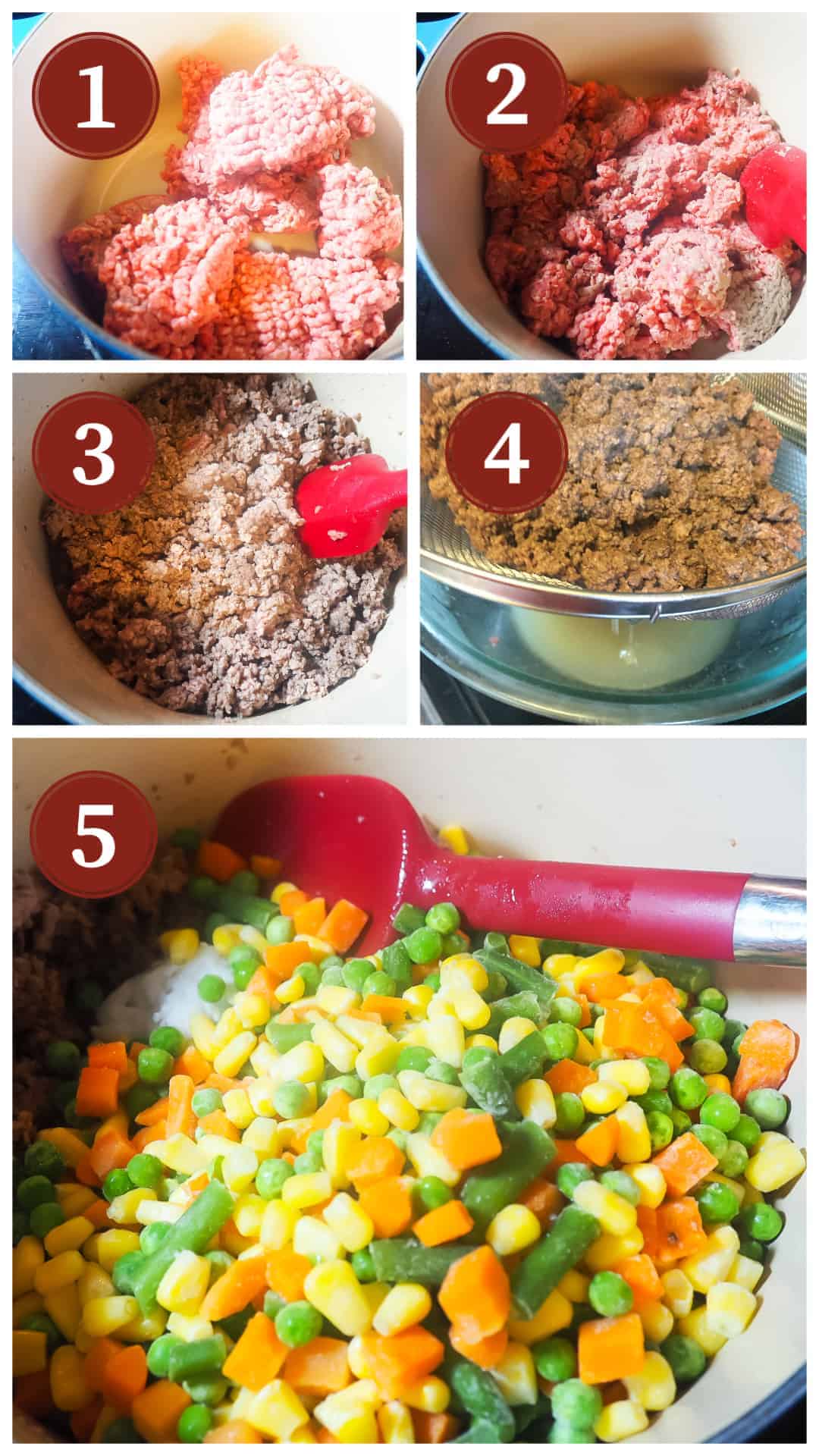
Mix well (Picture 6) then add your bone broth and oats. (Picture 7)
Bring to a boil, then reduce to a simmer until most of the liquid cooks off and the oats soften. (Picture 8)
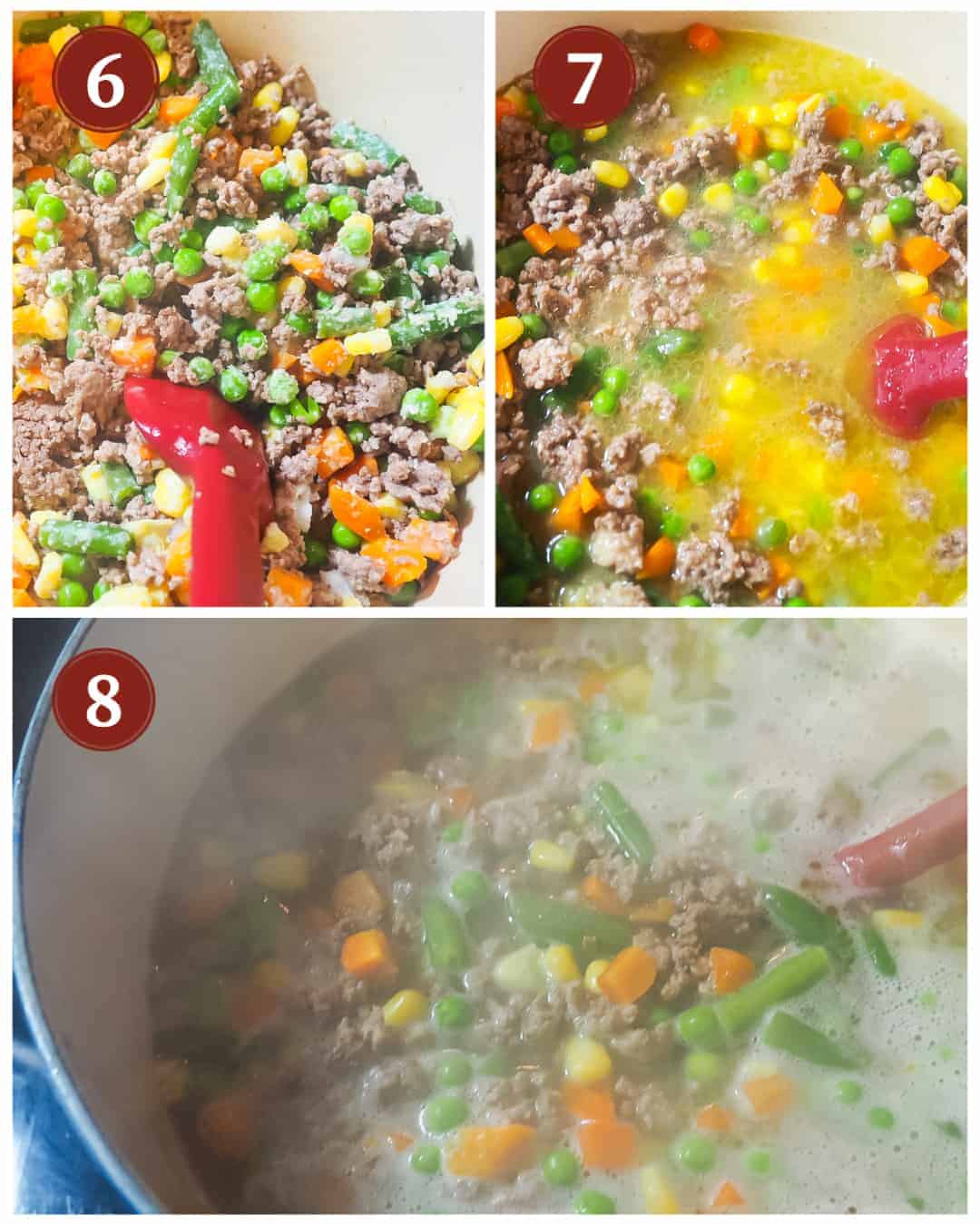
Remove your pot from heat and let your dog food cool before serving or storing. You can divide the food into portions depending on your needs – I usually split it in half and freeze one batch. I use a measuring cup when I serve the food, so I don’t take the time to split it into individual portions.

📖 Options
🥕 What Kinds of Vegetables Should You Use?
I like the mixed vegetable mix from either Walmart or Aldi that is peas or green beans, carrots, and corn. (Do not use anything with onions!) The last mix I bought had lima beans as well. You can also use a bag of just carrots mixed with a bag of cut green beans. (You know your dog so feed them what they like – this is such an easy recipe to use what you can get in the store/what is available!)
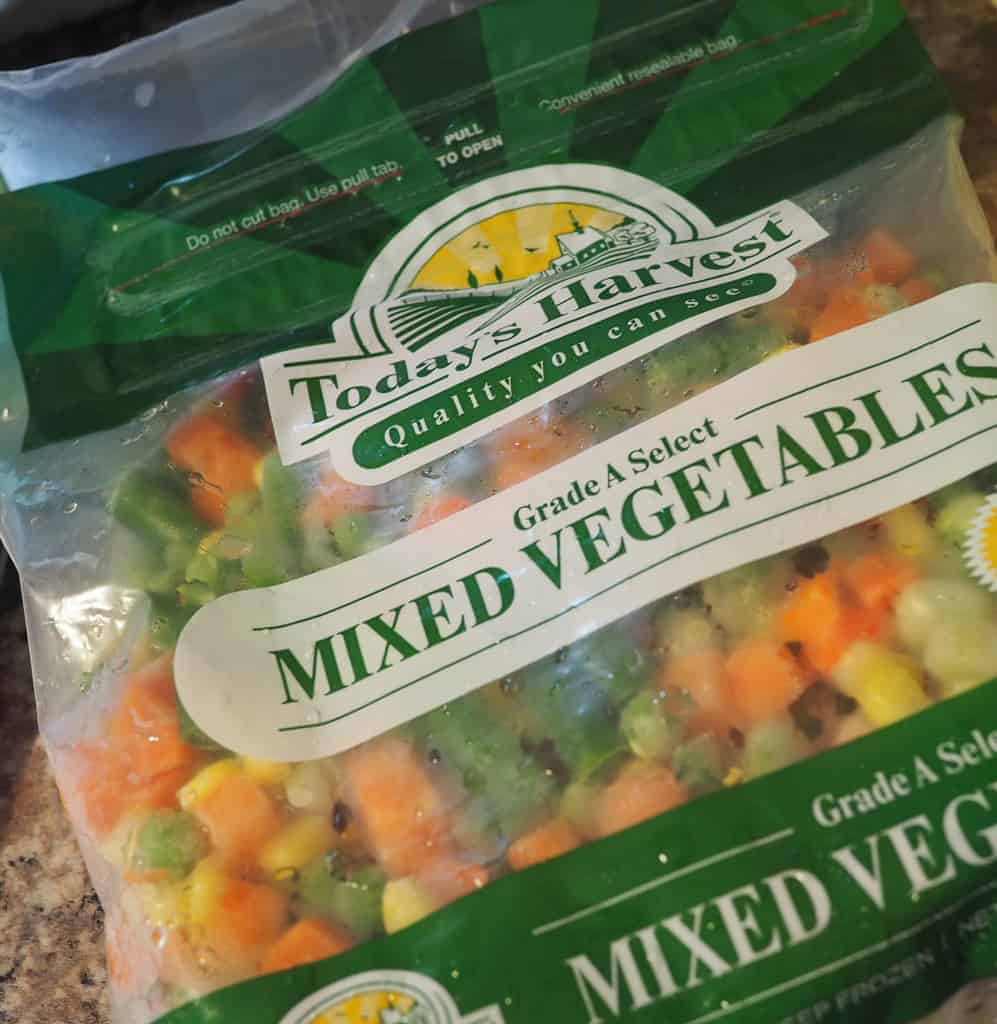
🍓 Can You Add Fruit?
Absolutely! Fruit has a lot of nutrients that are great for dogs. Just don’t go overboard with it. We often use what is in season or what we have in the freezer. We like to use some kind of berries – strawberries or blueberries are best. Do NOT use grapes as they are very bad for dogs. You can add fruit before or after cooking, just beware that if you cook with blueberries, your dog food will turn purple 😉
🌾 What Grains Can You Use?
The easiest grains to use in your homemade dog food are oats and leftover cooked rice. (Brown or white both work – obviously don’t use leftover takeout fried rice with onions!) If your dog has an allergy to grains, you can substitute diced sweet potatoes.
🥘 What Else Can You Add?
We like to add little bits of leftovers from all kinds of things: cooked duck(we don’t like to use this as the main source of protein because it is a little fatty, greasy, and heavy), roast beef, pot roast, grilled chicken.. even pork. We also sometimes add eggs, beef broth, duck broth, or sometimes even some wild game (she loves venison backstrap and some of those tough cuts that we don’t love!)
We supplement her diet with raw shank bones (frozen with marrow still in them) and raw pig’s feet. She loves them in all their disgusting, sloppiness.
🍲 Serving Size
The most important thing is to be sure and discuss serving sizes and ingredients with your vet before switching your dog to a new diet.
Here’s our personal experience: I give Melly 1 heaping cup of the food two times a day (with a small scoop of homemade yogurt on top) and she averages her weight somewhere between 40 and 45 pounds. She absolutely loves it! (In dry kibble, she eats 1 cup two times a day as well so you can start with the same amount and see if you need to increase or decrease it after a few days.)
If Melly has had an extremely active day, running around like the border collie she is and chasing squirrels up trees or patrolling the fence, I will give her a little extra at dinner. Our vet likes that we rotate different meats, veggies, and fruits – it gives her a variety of nutrients like a dog would find in the wild.
✏️ Helpful Tips
- Make sure that you don’t abruptly change your dog’s food – mix with their regular food or kibble for a few days until they are used to the new food. Your dog’s belly will thank you. And again, remember to always discuss with your vet before feeding your pet something new. (If your dog is coming off of already having some digestive issues, I would try using rice before oats as the grain source.)
- Top your dog food with a scoop of homemade or plain greek yogurt. It helps them get some good probiotics that aid in digestion.
- Rotate different meats, fruits, and vegetables to make sure your dog gets different nutrients. If your dog has a sensitive stomach, you might be best sticking to one combination that you know works 🙂
How to Transition to Homemade Dog Food
If your dog has spent their entire life eating kibble, make this transition slowly as they could end up with diarrhea. For dogs that eat a lot of table scraps, you could get away with replacing about ¼ of their food with this food for 3 – 4 days, then switch to half and half for 3 – 4 days, then ¾ new food + ¼ old food for 3 – 4 days, then 100% new food!
If your dog is really sensitive, I would do a week to two weeks at each stage. Melly has no problem with these transitions because I constantly add weird new things to her homemade food, but if your dog has eaten the same kibble their entire life, you should go slowly.
🍳 Serving Suggestions & Uses
I serve Melly’s food both hot or cold – she’s not very picky. I often top it with 1/4 cup of plain yogurt (with no sweeteners added) when serving. Yogurt is not necessary but provides probiotics and helps with healthy digestion. I like to make plain Greek yogurt in my Instant Pot.
Have You Tried This Recipe?
Please rate it and leave a comment below. I would love to hear what you think!
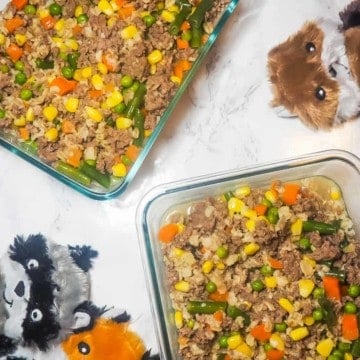
Easy Homemade Dog Food on the Stove
Ingredients
- 2 – 3 lbs ground beef or: ground chicken, turkey, or fresh fish – shredded chicken breasts work well too.
- 24 ounces frozen vegetables peas, green beans, carrot, and corn
- 1 cup frozen fruit I like to use blueberries and strawberries. (Optional)
- 1 – 2 cups leftover cooked rice or oats
- 1.5 cups bone broth
- 2 – 3 tbsp coconut oil refined or unrefined – whatever you have
Topping
- ¼ cup plain yogurt optional for serving
Instructions
- Cook 2 1/2 to 3 pounds of your choice of ground meat in a large pot on the stove.
- Drain off the cooking grease and discard once cooled. Return the cooked meat to your pot.
- First, add your frozen vegetables, fruit, and coconut oil.
- Once the coconut oil melts, add bone broth and oats.
- Mix well to combine everything.
- Bring the mixture to a boil then reduce to a simmer. Cook for 10 – 15 minutes until the broth is absorbed and the oats are soft.
- Remove your dog food from the heat and let the mixture cool. Divide into two portions – one for the next few days and one to freeze. (You can also portion the food into single servings if you feel so motivated.)
Notes
Special Equipment Needeed
- a large pot
Nutrition
Nutrition information is approximate and is automatically calculated, so should only be used as a guide.
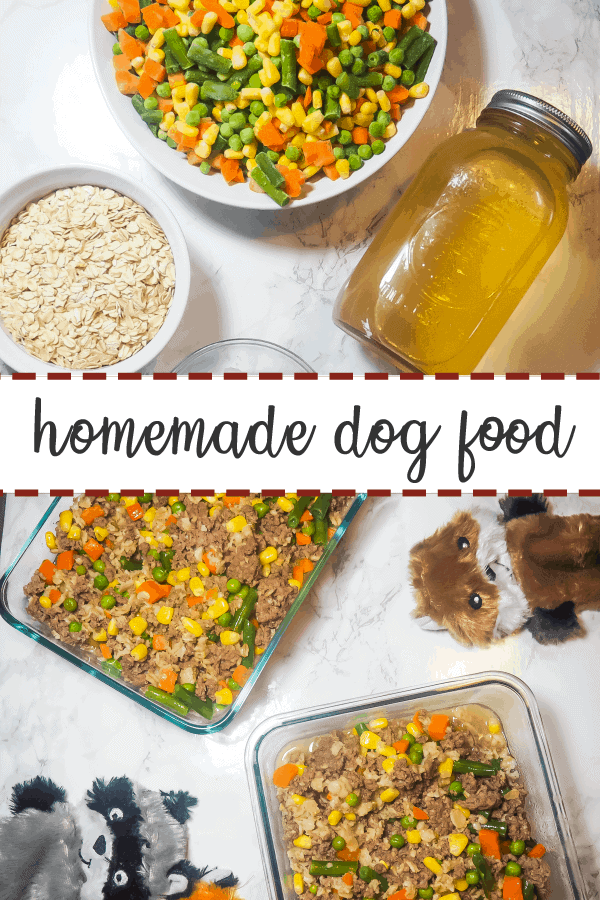
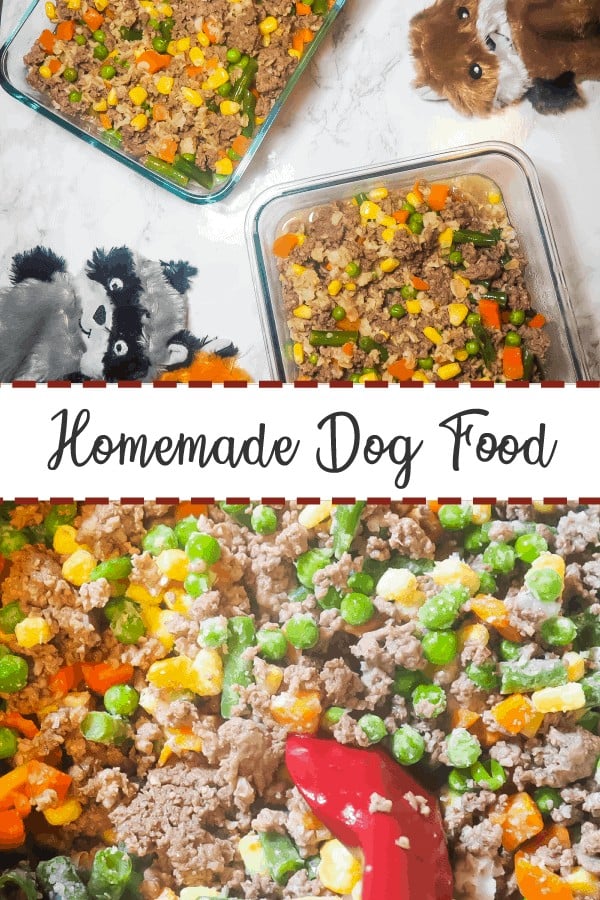
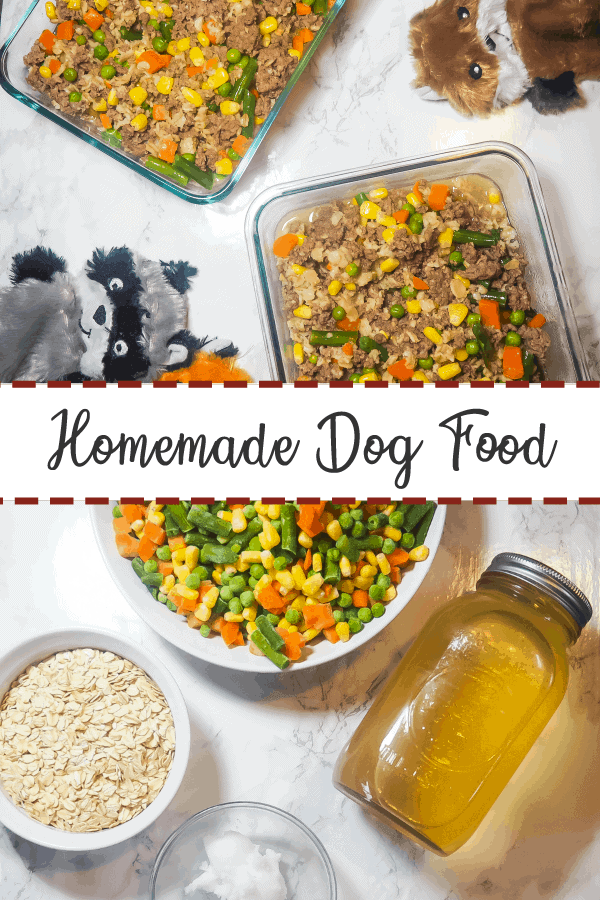
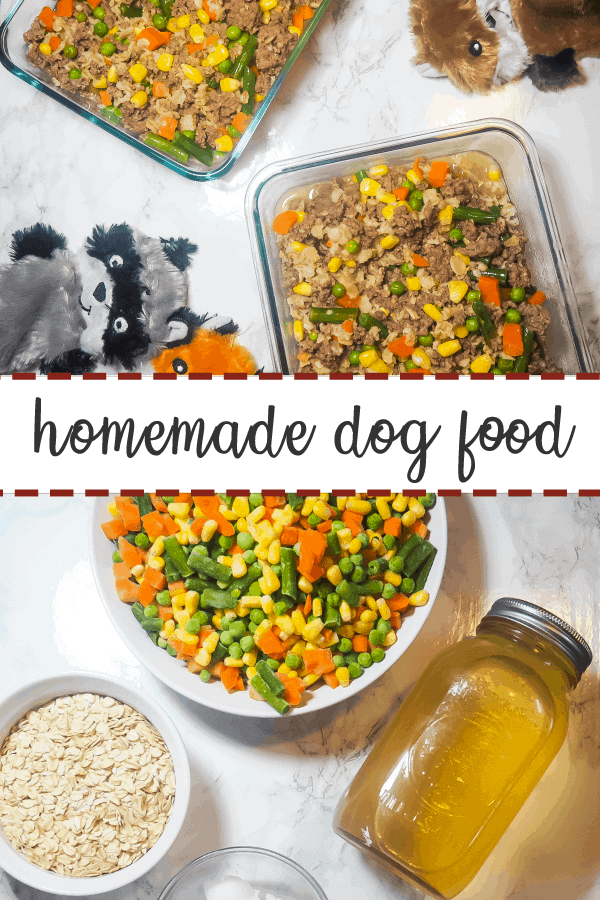
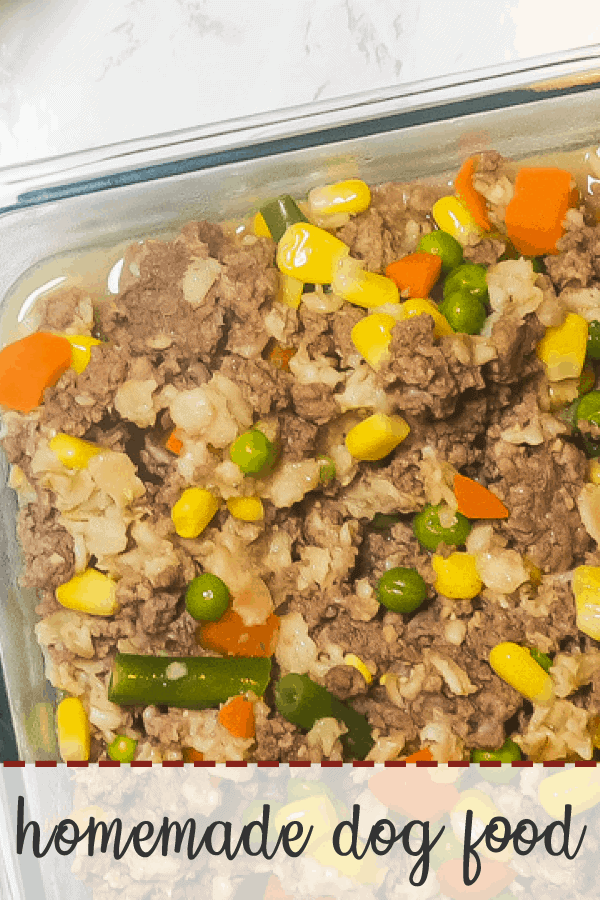
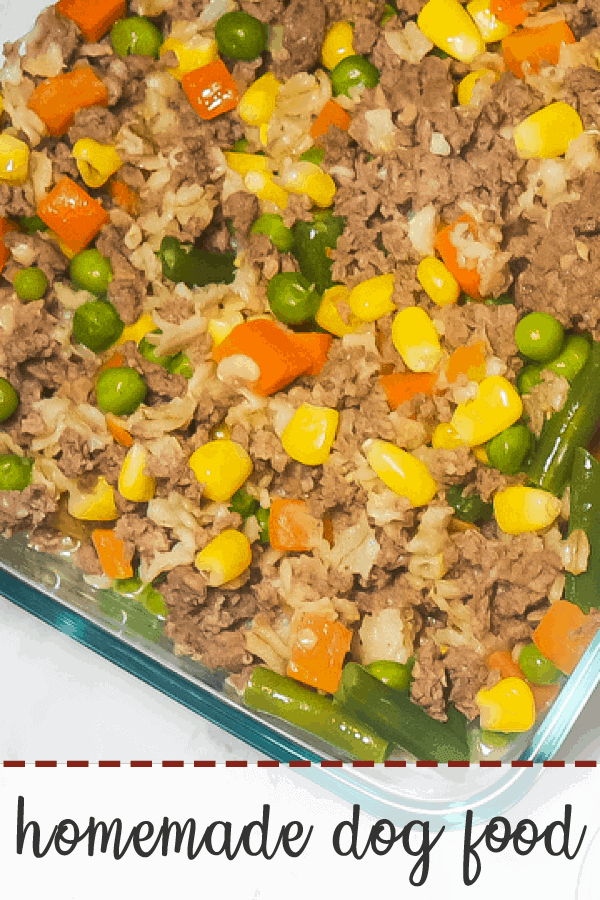
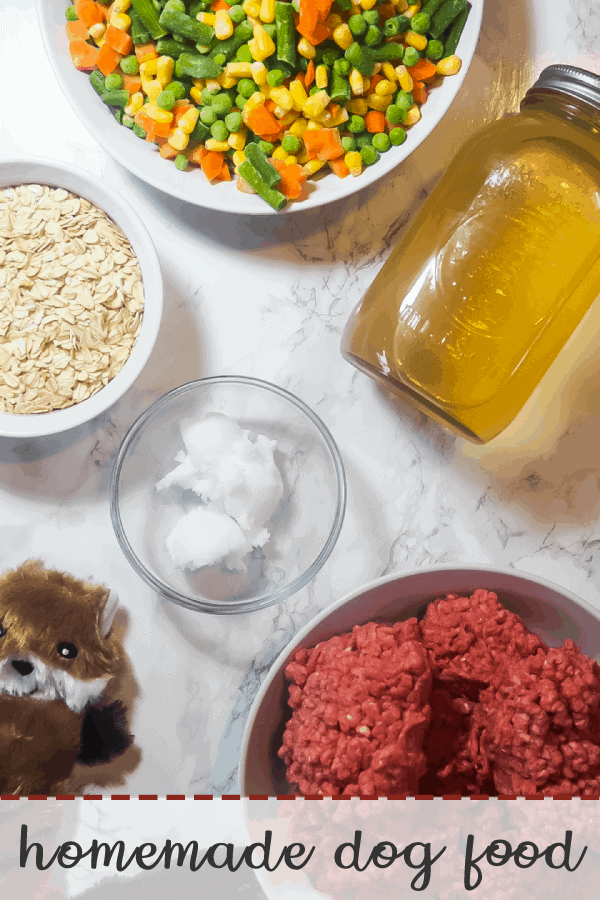

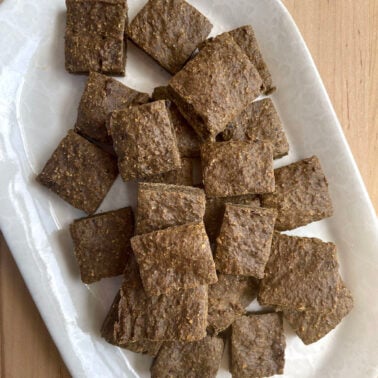
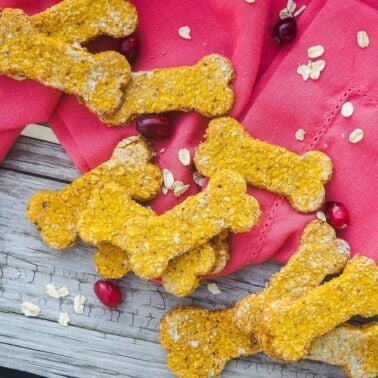
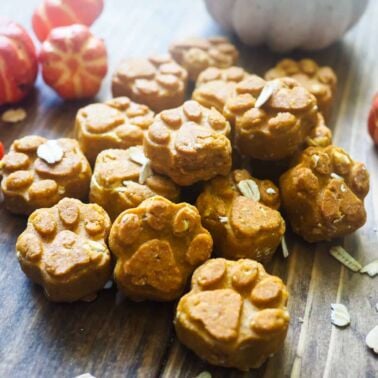
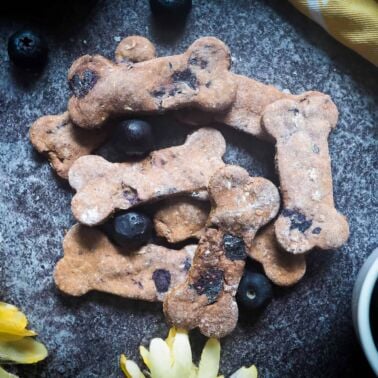









I’m actually just starting to transition to home cooked meals. River eats canned food and a cup of kibble for snacking. He is just tired of the same old can food which is now ridiculously expensive. Since I’m spending so much, might as well give him the best and home cooked, real ingredients, is a no-brainer for me. Your recipe is the best rounded one I have found.
I’m so happy to hear that! I hope River enjoys it – pass along some ears scratches for me 😍
I’ve been feeding my dog cooked food for a little while and he loves it. Today I tried your recipe using roasted chicken breasts (then chopped up in the food processor). I was worried he wouldn’t eat it because normally I shred the veggies so he won’t pick them all out. But OMG! he just gobbled up his dinner like there was no tomorrow. There wasn’t a single carrot piece or cranberry on the floor, haha! Thank you very much!
I’m so glad to hear this! Full bellies are much better than food on the floor 🙂
Hi. I transitioned my 2 dogs over to this diet for few weeks now & they love it! Only problem is they are losing weight. Idk if it’s because I’m not giving them enough or they are lacking something. They weigh 48 & 52 lbs and get 1.5 cups each, twice a day. Please help. Thanks.
Hey Nick! If they are losing weight, they likely need more food. Are they really active or high energy dogs? I give our dog lots of random little supplemental things in between meals – raw bones, liver treats, a kong or a lick mat with yogurt or kefir most days, so that adds to her calories – so they just might need more food!
My 10 month old shih tzu is 8.5 pounds and very picky. We are thinking of making your recipe. How much should I feed him daily? 1 cup of cooked food to that’s too much. According to some other sources he should be eating approximately 300 calories daily . Any suggestions? Thank you
1 cup would definitely be too much for him. Our dog is 45 pounds and she eats 1 cup two times a day. This article says that toy breeds should eat 1/3 – 1/2 cup of kibble a day so I would try 1/4 cup twice a day. Just confirm that with your vet and ease into it so he doesn’t get sick 🙂 I hope he likes it! 🙂